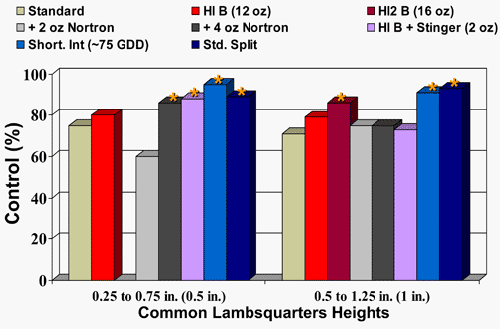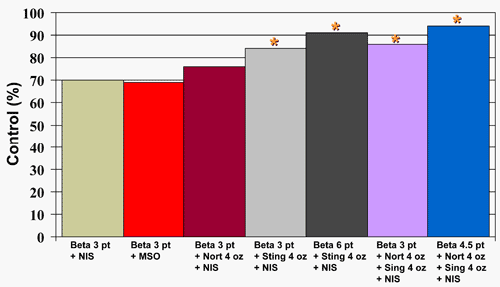Common lambsquarters escapes in sugar beets: What are my options?
Editor’s note: This article is from the archives of the MSU Crop Advisory Team Alerts. Check the label of any pesticide referenced to ensure your use is included.
Rainfall and inclement weather conditions have lead to common lambsquarters escapes in many non-Roundup Ready or conventional sugar beet fields. This is particularly prevalent in many of the sugar beet fields being treated with micro-rate herbicide programs. When application timings are missed, common lambsquarters is often the number one weed escape. Over the last several years, common lambsquarters escapes have been extremely common in sugarbeet fields at harvest. These escapes can reduce yield by competing for moisture and light, cause problems with topping and harvest, and produce seeds that will lead to future problems. In fact, one common lambsquarters plant can produce as many as 72,000 seeds per plant and these seeds can remain viable in the soil for as many as seven decades. For example, if one common lambsquarters plant escapes control and produces 72,000 seeds, after 12 years as many as 36,000 of those seeds will still remain in the soil. Missed micro-rate application timings and erratic weed control due to unfavorable conditions can exacerbate these problems. So, in 2006 with the help of funding by Michigan Sugar Company, two studies were designed to determine the best options for common lambsquarters control if a micro-rate herbicide application timing was missed. Since common lambsquarters escapes can also occur with other weed control programs the second trial was conducted to examine rescue treatments for common lambsquarters control.
Missed micro-rate application timings
A standard micro-rate treatment of Betamix at 8 fl oz/A + Stinger at 1 fl oz/A + UpBeet at 0.125 oz/A + 1.5 percent v/v of methylated seed oil (MSO) was applied to all treatments when common lambsquarters was less than 1/8-inch in height after planting. To simulate a missed micro-rate application, the second micro-rate application was delayed until 400 growing degree days, base 34°F after the first micro-rate (0.25- to 0.75-inch lambsquarters) application for half of the treatments and 500 growing degree days (0.5 to 1.25-inch lambsquarters) for the other half of the treatments. The strategies examined to overcome a missed micro-rate application included: 1) increasing the Betamix rate in the next micro-rate application (12 fl oz/A and 16 fl oz/A), 2) adding Nortron to the next micro-rate treatment (2 fl oz/A and 4 fl oz/A), 3) increasing the Betamix rate and the Stinger rate to 2 fl oz/A in the next micro-rate treatment, 4) shorting the interval for the next micro-rate treatment to approximately 75-100 GDD34 (3 to 5 d), and 5) switching to a standard-split application of 2 pt/A of Betamix + 0.25 oz of UpBeet + 0.5 fl oz/A of Stinger + 0.25 percent v/v of non-ionic surfactant (NIS). Each of these strategies were implemented at the two missed micro-rate timings and compared with a standard micro-rate treatment. The third and fourth applications of the standard micro-rate were then applied 225 growing degree days after the second micro-rate application for all treatments. Seven days after the last micro-rate application, common lambsquarters control was 75 percent when the standard micro-rate treatment was delayed 400 growing degree days and 71 percent when it was delayed 500 growing degree days (Figure 1). Regardless of the missed micro-rate timing, shortening the interval between the missed micro-rate and the next micro-rate application or switching to a standard-split application provided the greatest common lambsquarters control, 90 percent or greater. Increasing the Betamix rate and Stinger rate to 2 fl oz/A or adding 4 fl oz/A of Nortron to the standard micro-rate also improved common lambsquarters control compared with the standard micro-rate treatment for smaller common lambsquarters. For the larger common lambsquarters, increasing the rate of Betamix to 16 fl oz/A in the micro-rate also improved common lambsquarters control compared with the standard micro-rate treatment.

Figure 1. Common lambsquarters control 7 days after the last micro-rate
application from strategies to overcome a missed micro-rate application.
Rescue treatments for common lambsquarters control
In 2005 we conducted a study that examined several different options for control of escaped common lambsquarters. This study focused on increasing rates of micro-rate treatments and incorporating several different herbicides and/or adjuvants. At the time that the herbicides were applied in this trial, common lambsquarters heights ranged from two to 12-inches tall. There were no treatments other than glyphosate that showed any promise of lambsquarters control at this stage. This gives us an option in our Roundup Ready sugar beets, but what about our non-Roundup Ready sugar beets? The first step in keeping lambsquarters under control is to treat it at a much smaller stage. It is extremely important to recognize common lambsquarters escapes early. In our 2006 trial for control of larger common lambsquarters we treated common lambsquarters when plants were 1 to 5-inches tall and sugar beets were in the 4 to 6-leaf stage. Treatments that provided the greatest common lambsquarters control 14 and 21 days after treatment included: 3 to 4.5 pt/A of Betamix + 4 fl oz/A of Nortron + 4 fl oz/A of Stinger + 0.25 percent v/v of NIS or 6 pt/A of Betamix + 4 fl oz/A of Stinger + 0.25 v/v of NIS (Figure 2). Initially, the treatments with Nortron caused more sugar beet injury. All of these treatments are quite expensive, so it is important to get control of common lambsquarters before they get to this point.



 Print
Print Email
Email



